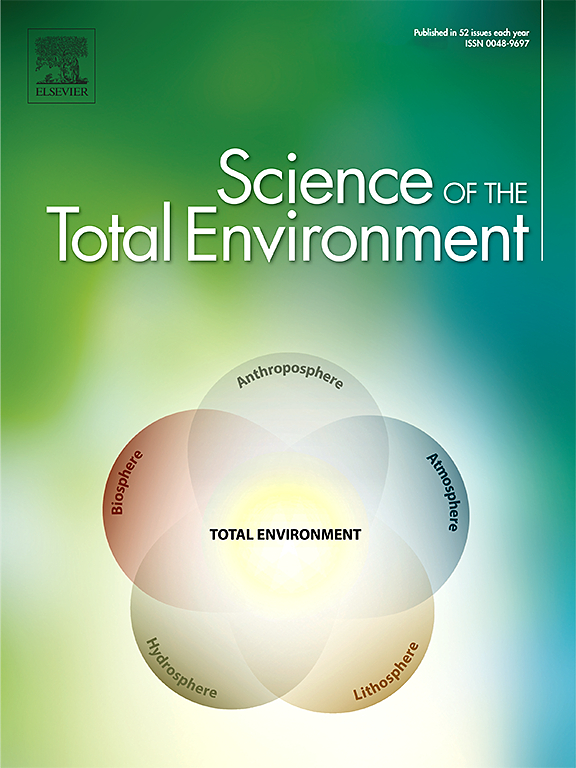Predicting nitrate leaching from alpine areas
IF 8.2
1区 环境科学与生态学
Q1 ENVIRONMENTAL SCIENCES
引用次数: 0
Abstract
We investigated the effects of changes in atmospheric deposition of inorganic nitrogen (IN = NO3− + NH4+) and climate change on NO3− leaching from N-saturated alpine catchments in the Tatra Mountains. This Central European mountain region provided a unique opportunity to assess the impact of the steep increase in atmospheric deposition of IN between the 1930s and 1980s, its largest global decline since the 1990s, and the recent acceleration of warming on long-term trends of NO3− concentrations in lake water. We analysed data on NO3− concentrations in 29 alpine lakes, together with observed and modelled trends in IN deposition and climate characteristics for the period 1937–2024. The results show progressive N saturation and NO3− leaching with increasing IN deposition until the late 1980s. Then NO3− leaching decreased, but at a slower rate than IN deposition in the 1990s–2000s, and finally reached a steeper trend than IN deposition in the last two decades, probably due to increasing air temperature. We hypothesise that longer and warmer growing seasons have partially mitigated catchment N saturation due to increased vegetation production and the input of plant biomass with high C:N ratios into the soil (i.e., increased organic carbon availability), which increases its ability to immobilise IN. Our results suggest that warming of alpine ecosystems has the potential to reduce their degree of N saturation and terrestrial NO3− export. Similar effects of climate change on the fate of deposited IN can be expected in other N-saturated alpine ecosystems worldwide.

预测高山地区的硝酸盐浸出
研究了大气中无机氮(n = NO3−+ NH4+)沉降变化和气候变化对塔特拉高山n饱和流域NO3−淋溶的影响。这个中欧山区提供了一个独特的机会来评估20世纪30年代至80年代间大气中氮沉降的急剧增加、20世纪90年代以来最大的全球下降以及最近变暖的加速对湖水中NO3−浓度长期趋势的影响。我们分析了29个高山湖泊的NO3−浓度数据,以及1937-2024年期间观测和模拟的氮沉积趋势和气候特征。结果表明,直到20世纪80年代末,随着IN沉积的增加,N逐渐饱和,NO3−浸出。随后NO3−淋溶下降,但在1990 ~ 2000年期间速率低于IN沉积,并最终在近20年达到比IN沉积更陡的趋势,这可能与气温升高有关。我们假设,由于植被产量的增加和高碳氮比的植物生物量的输入(即有机碳有效性的增加),更长的生长季节和更温暖的生长季节在一定程度上减轻了流域氮饱和度,这增加了其固定氮的能力。研究结果表明,高寒生态系统的变暖有可能降低其N饱和度和陆地NO3−输出。气候变化对全球其他氮饱和高寒生态系统中沉积氮的命运也会产生类似的影响。
本文章由计算机程序翻译,如有差异,请以英文原文为准。
求助全文
约1分钟内获得全文
求助全文
来源期刊

Science of the Total Environment
环境科学-环境科学
CiteScore
17.60
自引率
10.20%
发文量
8726
审稿时长
2.4 months
期刊介绍:
The Science of the Total Environment is an international journal dedicated to scientific research on the environment and its interaction with humanity. It covers a wide range of disciplines and seeks to publish innovative, hypothesis-driven, and impactful research that explores the entire environment, including the atmosphere, lithosphere, hydrosphere, biosphere, and anthroposphere.
The journal's updated Aims & Scope emphasizes the importance of interdisciplinary environmental research with broad impact. Priority is given to studies that advance fundamental understanding and explore the interconnectedness of multiple environmental spheres. Field studies are preferred, while laboratory experiments must demonstrate significant methodological advancements or mechanistic insights with direct relevance to the environment.
 求助内容:
求助内容: 应助结果提醒方式:
应助结果提醒方式:


